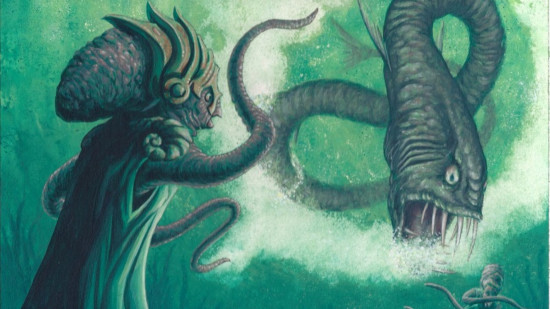Since Magic the Gathering fans spotted that a rules errata had removed the ‘Cephalid’ type from a bevy of old cards and replaced it with ‘Octopus’, head designer Mark Rosewater has been fielding questions from players who want to understand why it happened and whether more changes are coming.
Cephalids are an original Magic creature, appearing first and most frequently in the 2001 MtG sets Odyssey, Torment, and Judgement, and more recently on the MTG plane Capenna. On June 11 fans spotted that a new errata in the comprehensive rules document for Magic the Gathering had removed the creature type Cephalid from all cards and replaced it with Octopus.
If you search for the creature type “cephalid” in the MtG database Scryfall you’ll find that the only card with that type is ‘Learned Learner’, a novelty playtest card that is not legal in any constructed formats.
Judging by the questions being sent to Mark Rosewater’s blog ‘Blogatog’, some fans have taken this, and the previously-announced news that the Viashino and Naga creature types would be updated to lizards and snakes respectively, pretty hard.
“Just want to say how incredibly disappointed I am that Wizards is errata-ing Cephalid to Octopus”, commenter cle-guy states, adding “as far as I can tell nobody was calling for it, and I think it’s a flavor loss”.
Rosewater responds that this is actually a very long-standing practise: early in Magic design, the team “stopped using made up creature names for creature types” – which is why Leonin have been cats and Avens birds for decades. “All we’re doing is applying how Magic has done flavor types for twenty-five years and applying it backwards”, he adds.
User Wildcardgamez asks “Will minotaur become ox? Will merfolk become fish?” Rosewater replies: “Pre-existing names from things like mythology are fine, so Minotaur and Merfolk aren’t going anywhere”.
While ‘Nagas’ in MtG are an entity in several East Asian religions, they have current spiritual and cultural significance. Wizards of the Coast announced on November 3 2023 that it planned to change the Naga type to Snake, as one of several changes intended “to make our game as inclusive and welcoming as possible”.
Maro confirms that “the change to Naga was not inspired by” the same design principle that changed cephalids to octopuses.
In a later question, Wildcardgamez states “I feel like getting rid of types just because the fantasy races were made by you guys and not storytellers of the past is a bit sad”, which prompts a clarification from Rosewater: “We’re not getting rid of original creatures we made up… we’re just being consistent with how we treat made-up animal humanoids… a change we made in the late 1990s”.
In answer to another question, he confirms that this means “Vedalkens are staying Vedalkens” – the blue, aquatic, humanoids-without-tails aren’t merfolk, and don’t correspond either to recognisable mythology, or to a specific animal-creature.
But Rosewater states that homarids, sentient crustaceans, are likely to lose their unique creature type at some point. Rosewater speculates that they’re likely to become crabs.
Ashnodsfoodstamp asks: “Given MTG is a fantasy game, why the decision to switch away from evocative fantasy races to generic real-world animals?”, to which Maro replies “the evocative names are still used in names and flavor text” – the change only affects the creature type, which is used in rules.
Rosewater’s summarises that, with the exception of “made up races with no real world equivalent…” the design team “want to use words people recognize [in rules text]” for animal-humanoids “because “it makes the game more resonant and lowers the barrier to entry”.
“In mechanical rules space, familiarity is more important” than flavor, Rosewater explains. But he reiterates that flavor still has a home, in card names and flavor text.
If you don’t already read Blogatog, we highly recommend it. Over the three days of fielding these and other questions about creature typing, Rosewater finds time to discuss the likelihood of hypothetical sets appearing on the MTG release schedule, and the mathematics of drawing cards from a deck that contains an infinite number of clown tokens.
The influx of new octopuses is good news for anyone brewing a deck that cares about the wet creature types (Octopus, Kraken, Leviathan, Serpent) – if you’re running an MTG Arena Deck built around Runo Stromkirk, you just got a bunch of new tech. Check our guide to MTG Arena codes and see if you can pull a newly octopodal cephalid from Streets of New Capenna.
Source: Wargamer




